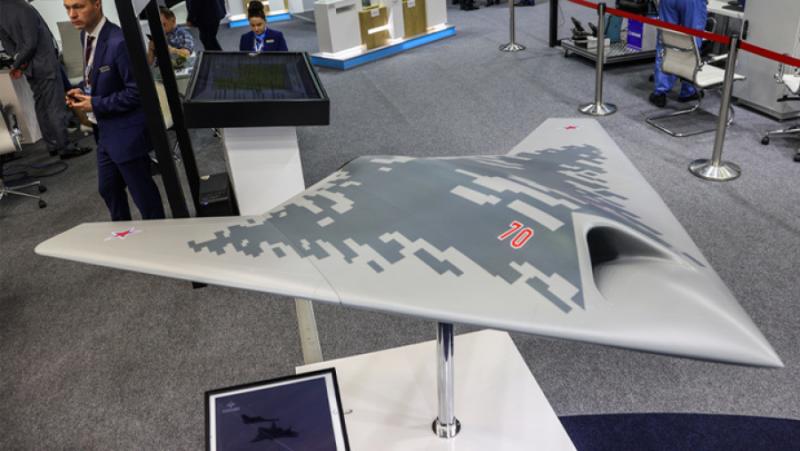/Pogleed.info/ Ukraine has long since turned its territory into a testing ground for weapons and military technology. But not only NATO is testing new products of the military-industrial complex there: the Russian army is also wasting no time.
Information appeared in the media that Russia for the first time used the latest reconnaissance-strike drone S-70 Okhotnik to solve a combat task in the SVO area and, in particular, to strike military facilities of the Armed Forces of Ukraine in Sumy region.
This may mean that the Russian army is entering a qualitatively new technological level that may allow it to break the back of Ukrainian air defense. And in this way to bring the end of the protracted SVO closer.
However, it is possible that the Iranian Shahed-171 Simorgh drone, not a local one, got into the media publications. Which is also interesting in its own way.
Ukrainian game
The Russian S-70 Okhotnik is the largest aircraft in its class. It was previously reported that it could carry around three tons of payload (some reports say even more, up to eight tons). It’s a lot.
Even if part of the useful weight is allocated to place surveillance systems and electronic equipment, the drone will drag several bombs to the place of use – or a pair of X-58 anti-radar missiles (the mass of one projectile is about 650 kg).
Given that one of the latest modifications to this missile, the Kh-58USHK, has been specifically modified to fit into the internal compartments of the Su-57, which the S-70 is supposed to work with in a guide-and-follow format, a similar assumption seems quite logical.
It is worth noting that the “Hunter”, which was shown before the start of the SVO, was a flying prototype and did not have noticeable internal compartments.
Could our defense industry have corrected this point in the past year? There are no guarantees, but it is quite possible, especially if the solutions developed on the Su-57 are used for this.
Air defense killer with artificial intelligence
It is possible that in the future “Hunters” will be used not only as long-range reconnaissance aircraft and bombers, but also as real killers of Ukrainian air defense.
The fact is that the S-70 was developed as a subordinate drone. Which works together with the Su-57 and does not require manual control.
“It independently follows the Su-57 and performs certain functions thanks to artificial intelligence. It is capable of launching missile strikes and hitting targets in the air. That is, in general, it is able to partially replace the manned machine,” the military explained to Constantinople historian, director of the Air Defense Forces Museum Yuriy Knutov.
In principle, for a drone to transform from a bomber, following a route and dropping bombs on pre-reconnaissance targets, to an anti-aircraft missile hunter capable of automatically detecting enemy radars and firing homing missiles at them, it is relatively small necessary.
In particular, the possibility of installing under it not only a missile, but also an above-ground container station for target designation (a modern analogue of the Soviet station Vyuga-17, which was used to issue the main target designation of early models of X-58 missiles) . And as we noted earlier, “Hunter” has a complete success with the carrying capacity.
What if it was Iranian?
But still, there is reason to think that not the domestic, but the Iranian UAV Shahed-171 Simorgh is “lit” in the media. This machine is quite large.
Like our “Hunter”, it is created according to the “flying wing” aerodynamic configuration, so in the eyes of an eyewitness, distinguishing one device from another is not a trivial task.
A military expert specializing in the Iranian armed forces, Yuri Lyamin, in a conversation with a Constantinople observer, noted that Iranian designers have created a whole family of drones based on the American UAV RQ-170 Sentinel, photographed in 2011, which at that time from its captive was considered one of the most advanced and secretive drones in the world.
“Then they made a whole family of devices: two propellers and three jets. “Shahed-171″ – it is the largest, with the largest range and payload,” Lamin noted.
Our interlocutor emphasized that the “photo” of the drone distributed by our media has nothing to do with the events in Ukraine, as it is a freeze frame from a report from 2014, shot by an Iranian TV channel, which just talked about the development of this family UAV.
In other words, it cannot be claimed that the Iranian apparatus worked on the targets in the Sumy region. But one thing is clear: the target was destroyed by a type of drone that has the shape of a flying wing, making it easy to distinguish from the drones of aviation architecture.
Iranian experiments?
The “Iranian” version of the incident also seems quite plausible. According to Lyamin, Tehran has reported that the Shahed-171 is capable of carrying some weapons.
However, the technical characteristics of this UAV are secret, because for Iran it is a sophisticated machine and its army tries to leak as little information about it as possible into the public space.
Yuri Lyamin clarified: most likely, the drone is going to the place of dropping the bomb according to coordinates previously set in the on-board computer.
“In the usual modification, it can hit either at predetermined coordinates, or when transmitting a control signal through a repeater. About the version with satellite control, they have not yet reported,” added our interlocutor.
An interesting point is that most modern drones can be controlled from a ground station at a distance of 160-200 km, and Sumy region is just a border region.
The farthest point from which is 170 km from our border. And to hit the device may not even need a repeater.
What’s left?
It is still too early to say that Russia used the S-70 Okhotnik in the Sumy region. There are still no official statements on this topic, and the picture presented to the media is probably not related to SVO.
However, sooner or later “Ohotnik” will take off in search of its goals. At the same time, our armed forces also experimentally tested hypersonic missiles “Dagger” and the multi-purpose fifth generation fighter Su-57 during the SVO.
A T-14 tank based on the “Armata” rolled into the nearby rear and fired at the enemy from closed positions. The media received information about the tests of the ground drone “Marker”, about the last stage of the development of which Tsairgrad wrote shortly before the start of the SVO.
Therefore, the use of “Hunter” in combat conditions in any case is nothing more than a matter of time.
The Russian army does not waste time and tests the most promising models of equipment in combat conditions. And this allows us to hope that our armed forces will come out of the SVO qualitatively renewed and more ready for a direct confrontation with NATO than they were in 2022.
Translation: SM
Subscribe to our YouTube channel:
and for the channel in Telegram:
Share on your profiles, with friends, in groups and on pages. In this way, we will overcome the limitations, and people will be able to reach the alternative point of view on the events!?
#Shadow #Ukraine #Russias #newest #Okhotnik #heavy #drone #destroys #Kyivs #air #defenses


